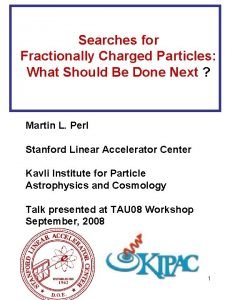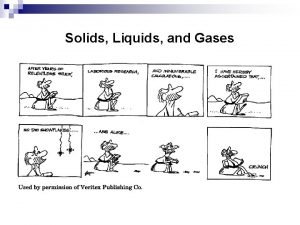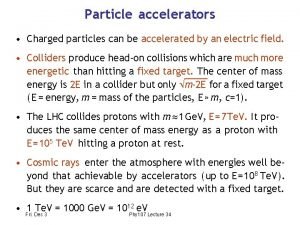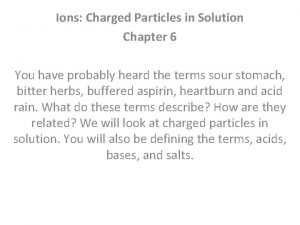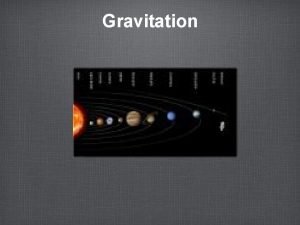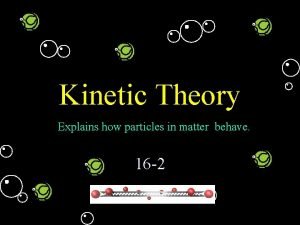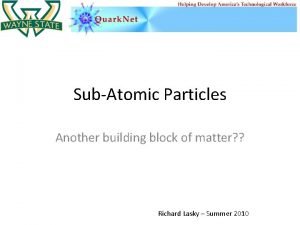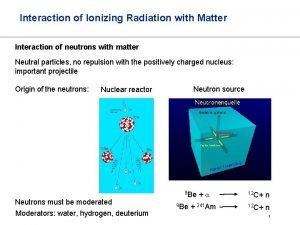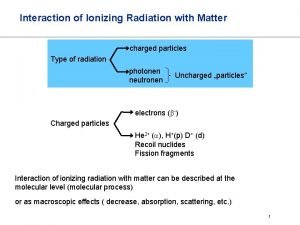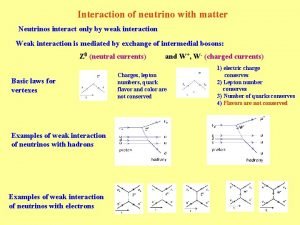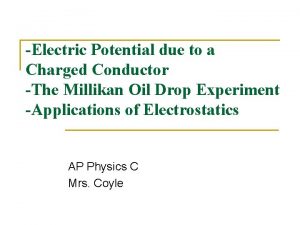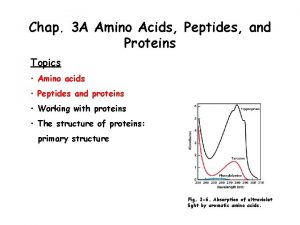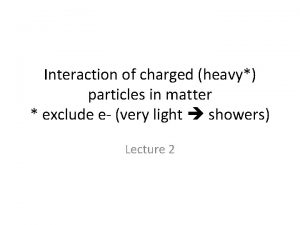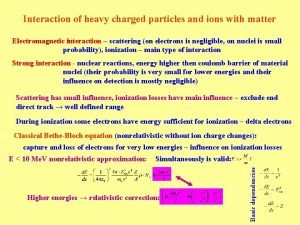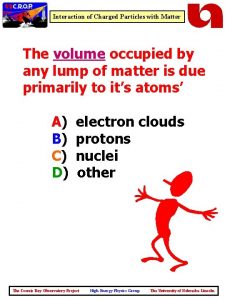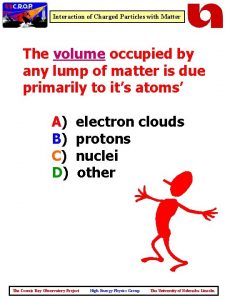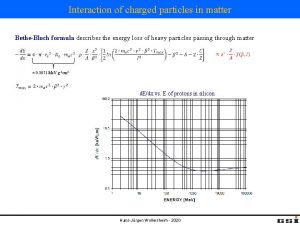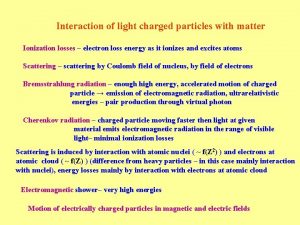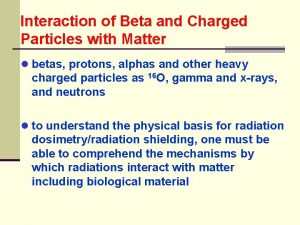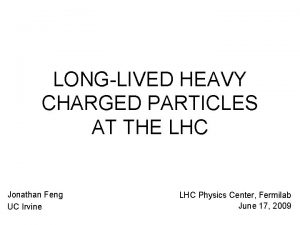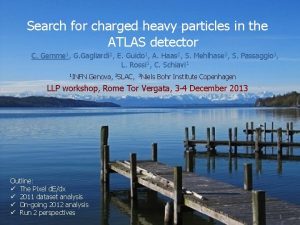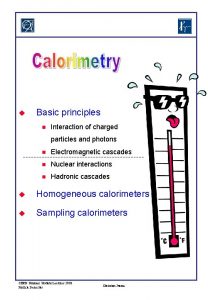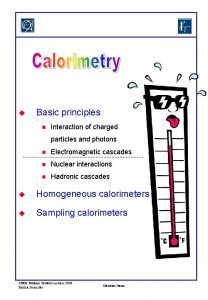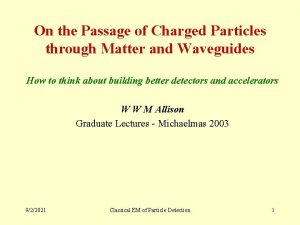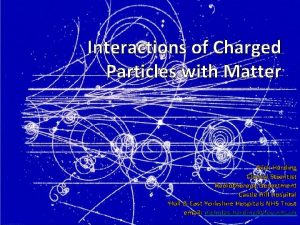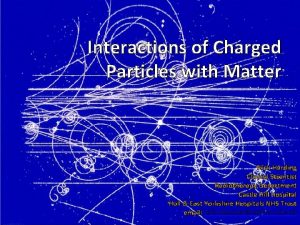Interaction of charged heavy particles in matter exclude
























- Slides: 24

Interaction of charged (heavy*) particles in matter * exclude e- (very light showers) Lecture 2

Dominant process for energy loss is the electromagnetic interaction with electrons of atoms. Interaction with nuclei negligible for energy loss, but they play a role in the angular deflection (multiple scattering). Particle M: mass, v: velocity (v=βc) Material refractive index: n, dielectric constant: ε = ε 1 + i ε 2 , dispersion Virtual or real photon Assumption: 1) Energy-momentum conservation: 2) Dispersion relation: With: and absorption

3 Regions, depending on the photon: 1) Below excitation energy (optical region) Cherenkov radiation 2) Excitation energy (2 e. V … 5 ke. V) (resonance region) complex with in general, can oscillate >1 Photons are virtual, no radiation but ionization by exchange of virtual photons. 3) Above excitation energy (X-ray region) Little absorption: Photons are virtual, no radiation except at discontinuities Transition radiation

3 Regions, depending on the photon energy: 1 100 1 K 10 K 100 K Photon energy [e. V] Optical Resonance X-ray Cherenkov radiation Ionization Transition radiation Re(ε)>1, Im(ε)=0 Re(ε)>oscillates, Im(ε)>0 Re(ε)<1, Im(ε) ->0 (vacuum properties, ε=1)

Transverse range of virtual photons In the resonance region: What is the transverse range of the virtual photons? relativistic rise How far can they ionize? Dispersion relation: 2 -dimensionl (z: longitudinal, y=transverse) from:

2 cases: 1) (faster than speed of light in medium, water, quartz, …) k y and kz real -> a real wave (Cherenkov radiation) 2) (slower than speed of light in medium, gas) k y imaginary damping Attenuation length: Attenuation length increases linearly with ! ->Expansion of transverse field! -> relativistic rise in energy loss!

Transverse range of virtual photons, relativistic rise: 2) 2 cases: (optical region) because for the optical region. If y 0 increases until where Cherenkov radiation sets in (above ionization threshold) y 0 increases with until up to a maximum: This is the “relativistic rise” increased transverse range -> interaction with more atoms effect saturates when:

Transverse range of virtual photons, relativistic rise: Fermi-Plateau This saturation (described by ε) is classically due to the polarisation of the medium, which will screen the effect of remote atoms. This effect is larger in denser media “Density effect” -> see density correction in Bethe-Bloch




Bethe-Bloch formula The mean energy loss of relativistic charged heavy particles is described by the “Bethe-Bloch equation”. (max. kin. Energy transferred to free electron in single collision) relativistic rise number of charges of incident particle density correction

Bethe-Bloch formula Discussion: • Function of β only independent of M! -> d. E/dx used for particle identification. P can be measured in B-field -> v from d. E/dx -> M calculated • Valid for βc larger than that of orbital electrons (~Zαc), small enough that radiative effects do not dominate. • Dependence on material small ~Z/A , except for hydrogen • I Mean excitation energy, trickiest part! For elements heavier than oxygen. Minimum ionization at In typical high energy physics experiments, most particles are minimum ionizing (MIP) or above. Relativistic rise from extension of transverse range counteracted by, Density effect limitation of transverse range through polarization of medium large correction for high density 50%-70% relativistic rise for noble gases much less for liquids and solids.



Energy loss in Si Proton heavier than μ -> βγ smaller for same E Minimal ionizing 1 Mip = on average 32500 e- - hole pairs in 300 μm Si


Cherenkov radiation detector A charged particle with velocity β in a medium with refractive index n may emit light along a conical wave front. The angle (Cherenkov cone half angle) of emission is given by: And the number of photo electrons detected in a given device: ε(E): Efficiency for collection and detection of Cherenkov light L: Length of the detector radiator n(λ): Wavelength dependant refractive index N 0: Detector quality factor The detection efficiency and the Cherenkov angle depend on the photon energy E. As the typical energy dependent variation of n is small, the integral can be split into the mean value for the sin 2θ and the detection efficiency. with

Cherenkov detectors

Cherenkov angle for different radiators in LHCb RICH • • Each radiator is optimized for a different momentum region Particle identification PID is based on the measurement of the Cherenkov angle. Small θC ensures good velocity Resolution (i. e. mass) resolution. But, NPE grows with θC and ΔθC , so The detector is inefficient if they are too Small.

RICH in LHCb

Transition radiation detector TRD • • Transition radiation is electromagnetic radiation emitted when a charged particle traverses a medium with a discontinuous refractive index, e. g. the boundaries between vacuum and a dielectric layer. Radiation energy per medium to vacuum boundary transition • • Only high energetic e+/- emit TR of detectable intensity and can be used for PID. Plasma frequency ( for plastic radiators) Build a detector with many transitions (foil stack) to enhance signal. Typical photon energy is in the x-ray region. Angular emission is (stay close to track). Particle must traverse a minimum distance, the so-called formation zone Z f in order to efficiently emit TR , Zf(air)~mm, Zf(CH 2)~20 um, important for detector radiator design.

Radiator, fleece based TRD Xenon straw tubes for x-ray detection, traverse the full length fleece removed for illustration Particle

 For charged particles, what is the quantity q/m called?
For charged particles, what is the quantity q/m called? The search for fractionally charged particles has
The search for fractionally charged particles has Gas like mixture of charged particles
Gas like mixture of charged particles Charged particles can be accelerated by
Charged particles can be accelerated by Chapter 6 ions charged particles in solution
Chapter 6 ions charged particles in solution Ratey method
Ratey method Restic exclude directory
Restic exclude directory Title fly and title page
Title fly and title page Mutual force of attraction formula
Mutual force of attraction formula The kinetic theory explains how particles in matter behave
The kinetic theory explains how particles in matter behave Building block of matter which contains subatomic particles
Building block of matter which contains subatomic particles What is interaction of radiation with matter
What is interaction of radiation with matter Ionizing radiation
Ionizing radiation Neutrino interaction with matter
Neutrino interaction with matter Ecological succession
Ecological succession Gray matter
Gray matter Classification of matter section 1 composition of matter
Classification of matter section 1 composition of matter Section 1 composition of matter
Section 1 composition of matter Section 1 composition of matter
Section 1 composition of matter Gray matter and white matter
Gray matter and white matter Chapter 2 section 1 classifying matter answer key
Chapter 2 section 1 classifying matter answer key Frontal and parietal lobes
Frontal and parietal lobes What makes up the diencephalon
What makes up the diencephalon Electric potential due to a charged conductor
Electric potential due to a charged conductor Positively charged amino acids
Positively charged amino acids

